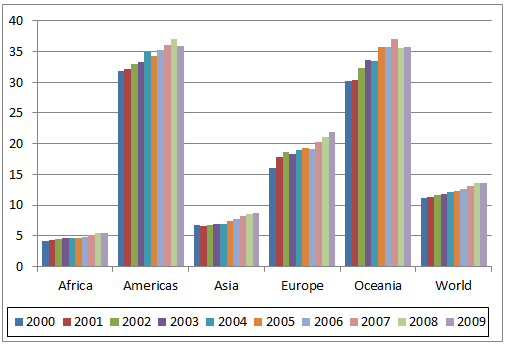



GLOBAL POULTRY TRENDS 2012 - Chicken Consumption Steady in Oceania, Rising in Africa
The long-term trend of gradually increasing poultry meat consumption is expected to continue in Oceania, according to industry expert, Terry Evans, while in Africa, total uptake is booming but growth is more modest on a per-capita basis.Poultry Uptake Booms in Africa
Poultry meat consumption has boomed by almost 35 million tonnes (51 per cent) since 2000 to total possibly 103.5 million tonnes in 2012. For chicken meat, the increase has been more than 32 million tonnes (55 per cent) to around 91 million tonnes in 2012. On a per-person basis, the increase has not been so dramatic because of population growth. The Food and Agriculture Organisation of the United Nations (FAO) has not updated its consumption data since 2009 nevertheless, between 2000 and 2009, average consumption on a global basis expanded by 2.5kg per person and year (22.5 per cent) from 11.1kg to 13.6kg (Table 1 and Figure 1). Since then, poultry meat consumption per person has continued to rise by the best part of 1kg to average around 14.6kg in 2012.
For Africa, the increase has been nearer 0.5kg per person bringing the average for the region towards 6kg. But, as we have said in many of these reports, the per-person consumption figures must not be taken too literally as there is considerable scope for errors in the calculations of both available supplies and population numbers. However, on the assumptions that the same methodology has been adopted when making the calculations, then trends in the data give a reasonable guide as to what is happening to consumption in a country.

Currently, the human population of Africa estimated at 1,070 million represents 15 per cent of the world total. Projections to 2030 foresee continued expansion at a little above two per cent a year, putting the total at 1,562 million or almost 19 per cent of the global figure of 8,321 million.
It is clear from the available poultry meat consumption data (Table 1) that, for most African countries, poultry uptake is extremely low, which at least points to the potential for considerable expansion in the per-person figure, assuming that improvements in real incomes are spread throughout the populace. Even without any increase in the average uptake per person, the demand for chicken meat will be in the region of 7.5 million tonnes a year by 2020.
There is little current information about consumption in the individual countries in this region.
In South Africa, poultry uptake averaged 36.12kg per person in 2011, of which chicken contributed 35.7kg, according to the South African Poultry Association. However, much of the growth in consumption was met by imports (up 32 per cent), while the domestic industry's contribution rose by only one per cent.
Chicken continues to be the most affordable protein source in South Africa compared with its competitors. At 36.1kg in 2011, poultry uptake was well ahead of beef at 16.62kg, pork at 4.6kg and mutton and goat combined at 2.7kg. In 2011, retail sales accounted for 52 per cent of chicken sales, followed by the wholesale trade taking 25 per cent and the food-service sector, 15 per cent. Compared to the previous year, the food-service sector gained ground at the expense of both the retail and wholesale trade. Without doubt, a major contributor to the rise in the popularity of chicken has been an increase in the availability of value-added and convenience products.
That the tourism trade is in the doldrums has impacted negatively on the demand for chicken in Egypt, as is the law banning the transportation of live birds between districts, as Egyptians prefer freshly killed poultry to frozen birds. Nevertheless, there is optimism that improvements in wages will further boost consumer demand.
Slow Population Growth in Oceania
Oceania's population is expected to increase slowly at a little over one per cent a year from the current near 38 million to more than 47 million by 2030. According to FAO data, average poultry uptake expanded from 30.2kg per person in 2000 to 35.7kg in 2009 (Table 2).
Poultry meat consumption in Australia is expected to have slipped a shade in 2011/12 from 45.3 to 45.2kg per person. For 2012/13, poultry meat uptake is forecast to rise to 45.5kg, growing by 0.5 per cent a year to reach 46.4kg per person by 2016/17, as it maintains its status as the most popular meat.
Poultry consumption in New Zealand increased from 14kg per person per year back in 1986 to more than 34kg in 2007. However, it then contracted to around 30.4kg by 2009 as part of a general cut-back in meat consumption. Nevertheless, it has continued to be the most popular meat, representing some 36 per cent of total meat uptake followed by beef and veal (31 per cent), pig meat (22 per cent) and mutton and lamb (11 per cent). Based on the recovery in chicken production and population growth of less than one per cent a year, the consumption of poultry will since have recovered somewhat but will still not matched the near 35kg recorded in 2006.
October 2012











